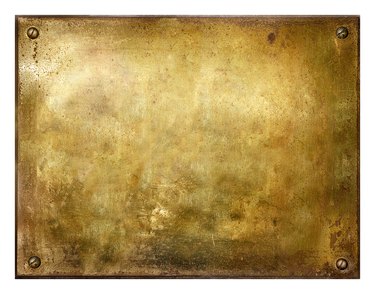Brass is one of the most popular materials used in interior design, particularly in older buildings. Hardware fixtures, doorknobs, plaques, coat racks and many other details of a home are often crafted in brass. While the metal has a beautiful sheen, it can change over time due to oxidation. While to many people oxidated brass can look unsightly, it is a condition that can be treated.

What is Oxidation?
Oxidation is a chemical reaction that occurs when brass, a copper alloy, comes into contact with the air. Generally, when brass is first produced it is sealed in a lacquer, but this lacquer wears away over time. With regular use and handling, the brass itself is exposed to the oxygen in the air, and oxidation occurs which results in a tarnish or patina on the surface of the brass that keeps it from looking clean and bright.
Video of the Day
Video of the Day
While oxidized brass doesn't always look as nice as brass in its original state, the oxidation process allows the brass to create a protective coating or patina on its exterior to prevent further corrosion or damage.
Brass contains a significant amount of the element zinc, and is therefore susceptible to a process known as "dezincification." This occurs when zinc erodes and the copper retains its shape but not its strength, and results in copper crumbling and falling apart. This is particularly problematic when the brass serves a function beyond decoration, such as a pipe, a bolt or some other connective function. Corroded brass that has weakened can be extremely dangerous.
Identifying Corroded vs Oxidized Brass
Generally, brass corrodes when the zinc, copper and tin components of brass alloy are exposed to water. This is a danger for brass pipes, exterior window casings and the hardware on boats. Corrosion in brass is easily identifiable by reddish or pink splotches on the surface of the object. In addition to the impact of water, exposure to mercury and ammonia can also cause brass corrosion.
Oxidation, on the other hand, looks very different. Oxidized brass is typically blackish, green or blue, and hardens like a thick crust over the surface of the brass. This coating typically flakes off and can be removed to reveal the shiny brass surface. Oxidation has no effect on the integrity of the brass the way corrosion does. Some people leave the brass oxidation on for decorative effect, and it is known as a "patina." Sometimes patinas are deliberately applied to create an aged or weathered look.
How to Clean Brass Oxidation
Cleaning brass can be accomplished with household cleaners easily found at Home Depot or other home improvement stores, but it is also possible to clean brass oxidation naturally without the use of chemicals. Make a natural brass cleaner by squeezing the juice from half a lemon into a bowl, and add about a teaspoon of baking soda and stir until mixed. Apply the paste with a soft cloth to the oxidized brass. Once you've worked the paste into the brass, rinse it with water and then immediately dry it thoroughly with a clean towel to avoid additional damage from water exposure.